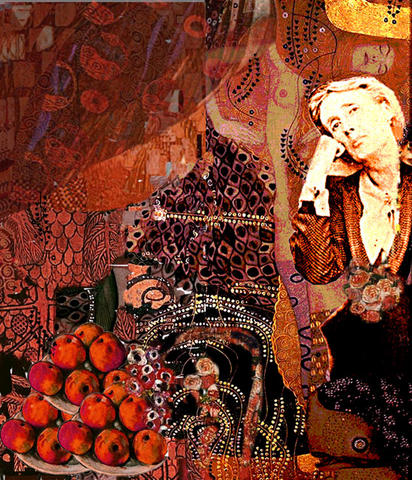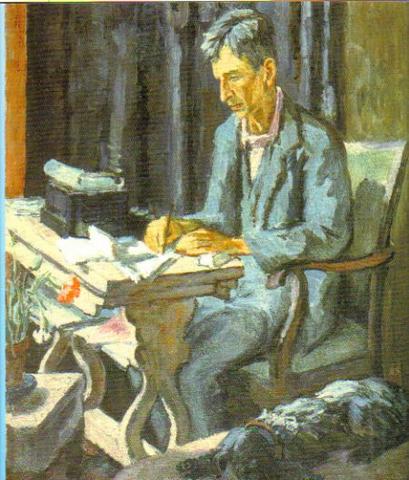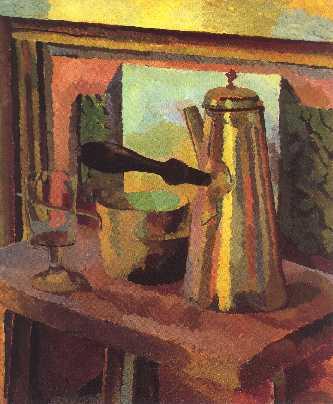Ellen and Jim Have a Blog, Too
We are two part-time academics. Ellen teaches in the English department and Jim in the IT program at George Mason University.


Virginia Woolf at the MLA & Leonard Woolf on the train · 16 January 07
Dear Sylvia,
Last year I went to one session of the MLA dedicated to Virginia Woolf; this time I went to two. In two others whose ostensible topic was Women and War and the Literature of Terror people offered papers on Woolf or seemed to me to discuss topics that her work illuminates. We also went to a party given by the people who run, are, and encourage others to belong to, the International Virginia Woolf Society, where we meet Woolfians and discussed (among other things) film adaptations of Virginia Woolf’s novels (especially To the Lighthouse), and job politics. On the way to and from Philadelphia I read Victoria Glendinning’s great biography (it’s her best thus far), Leonard Woolf.

Elisa Kay Spark, Seraglia (1996)
All this enthusiasm is not simply the result of having spent this past summer and fall reading and discussing Woolf with a group of people on WWTTA. I’ve loved her criticism, autobiographical writing, and The Voyage Out for years. I twice taught her Room of One’s Own and Three Guineas as part of a course where we covered the literature of WW1 and WW2 (as well as "between the acts"). Now I am convinced To the Lighthouse and The Years are masterpieces, and her remarkable essays on autobiography and her brilliant short biographies important to literary study in general.
I begin with the first of the two sessions on Woolf, "Street life: Virginia Woolf and Public Spaces" (8:30-9:45 am, Thursday). Lisa Tyler discussed attitudes towards modern technology in the characters of Mrs Dalloway. Prof Tyler began with cars: she said from early 1910 to 1920, something like 100,000 people in the UK maintained cars; by 1932, 2 million did. What are people’s actual responses to the new physical plant of their environment? Prof Tyler arged that for Virginia Woolf technology has no value in and of itself. It depends how it is used. Her characters reveal themselves as they visualize technological equipment. Mrs Dalloway is at first partial to omnibus travel; later on experience outside the bus have also engengered in her terror. She feels frail but is exhilarated. Richard Dalloway looks on traffic as a social problem, and feel only large public institutions could help what he perceives as a problem. Elizabeth has no desire to assert herself, to enlarge the uses of autonomy.
Adam Hammon gave a wonderful paper on Virginia Woolf’s one relatively long poem "the “Ode Written Partly in Prose on Seeing the Name of Cutbush Above a Butcher’s Shop in Pentonville," written in 1934 and never published." Its opening strong line is "I salute thee, passing." Cutbush reads Byron! The poem has published in A Haunted House: The Complete Shorter Fiction, ed. Susan Dick. New York: Vintage, 2003, pp. 231-235. The poem, Woolf’s essays, e.g., "The Narrow Bridge of Art” and her novel, Mrs Dalloway emphasize "The paradox of proximity by which residents are brought into increasingly alienated concentration and in which the jealously guarded vestiges of personal space are permeated on all sides by the technologies of communication." We are farther apart and close together than ever before. Poetry has failed to deal openly and directly with this growing gap between people who can reach across borders and other communities to meet one another, but yet live utterly apart in the spacial dislocations of cities, towns, villages off highways. He suggested Woolf shows us to read newspapers like poems and read public spaces like poetry.
Melissa Sullivan discussed how social experience is divided up for women into community or communal spaces where they are safe from sexual harassment (no small thing) and spaces where they are not harassed and yet not fully welcome to be themselves. In Woolf’s Between the Acts she wants to rescue an idyllic retreat insofar as that’s possible. Great houses provide alternative spaces, and do not have to function as elite tropes; inside such a house, relationships between people can emerge; such a house can produce unpoliticized poetry.
Vara S. Neverow was the respondent. She began by quoting passages about and by Woolf walking in a rural setting. In these she or her protagonist is a wandering character, someone who relishes her anonymity (gives her some freedom). She quoted Woolf on the urban scene: Woolf has essay-like picturesque passages describing open coal holes, 4-wheeled cabs. Prof Neverow declared Woolf’s vision is a hybrid of disparate impulses and finished art.
Duncan Grant (1885-1978) Coffee Pot (1918)
For an early Sunday afternoon session (No 701, 12:00 noon to 1:15 pm), the second session I attended, Rereading Trauma in Woolf’s Fictional Corpus, was remarkably well attended. (Many conference members have left or are fleeing to make a connection around that time). It was based on the essays published in a new book on trauma in Virginia Woolf and I heard two moving essays. (I couldn’t stay for all 4 as we too had to get to our train.)
Jane Lilienfield’s "There was an Emptiness about the Heart of Life: Traumatic Shock, World War I, and Mrs Dalloway," demonstrated how much of Woolf’s texts are directly influenced by and mirror the traumatic shock of WW1. Prof Lilienfeld wants people to see that Mrs Dalloway is a prose equivalent of the powerful body of poems, mostly by men, written during and about WW1 (by Owens, Sassoon, Blunden, all the poems in Jon Silkin’s great anthology of WW1 poetry for Penguin). The horrendous casualties are seen through the lens of a British pastoral. Woolf is tunnelling back in time and asks how safe are we today, how safe her characters. Trauma breaks in unexpectedly, terror. What is a traumatic event, one that inflicts some radical psychic wound. Trauma happens silently, unseen in the night: in To the Lighthouse Mrs Ramsay’s death is announced this way: "one dark morning he walked bewildered as he remembred her death ... ". Prue’s death in childbirth, Andrew’s blow up are reported.
Suzette Ann Henke’s paper was a piece taken from her essay in Rereading Trauma in Woolf. She read its opening and the section on The Waves. I’ll begin with what she said about this novel. The Waves shows us existence moving towards death; the characters are "touched by the fire of melancholia," and this is shown to be a "realistic response to existential anxiety." We are unable to deal with unforeseen death, accidental death; this novel has a "haunting awareness of the fragility of life." When Leonard Woolf wrote the journey, not the arrival matters, he meant annihilation (death) is the great enemy, making all meaningless. We must celebrate all beauty that can flourish (from flowers to crumbling walls), the moments of vividly lived being, courageous persistence in the face of the indifferent cosmos and nothingness. True heroism lies in spiritual endurance, open resilience agains the traumas of aging and death. Woolf’s characters at their most moving fling themselves against death.
The first of the two sessions which included papers on Woolf was "The Politics of Engagement", which I discussed in my letter on women in the long 18th century at the MLA. The second as a whole connected to her work, "Literature and Terror" (No. 373, Friday, 8:30 – 9:45 am). One paper, for example, was about the coterminus terrain of terror, death, and the sublime. Death alone allows us to grasp meaning, give a pattern and awe to reality. This paper included extensive quotation from a speech by Robespierre where he justified using terror on those who theaten "virtue"—the very opposite of the ethics of indifference Prof Hollander had attributed to Woolf in Three Guineas.
Shireen Patell talked about how the "Tick Tock Tick Tock" of terror, the diurnal experience of it is central to our consciousness it is there, on the edge of safety all the time. She said against this we must take responsibility for one another’s tranquillity. She analyzed Woolf’s Mrs Dalloway & McEwan’s Saturday. They both show a hyperconsciousness of time. In Woolf against the repeated promise of a new beginning there is the impossibility of forgetting the daily horrors of life (e.g., how physicians simply bully you).
I’ve already mentioned Glendinning’s book on Woolf to you and talked about the reviews. I won’t repeat what I’ve said already, rather add to it. Glendinning portrays Leonard Woolf beautifully, tracing the childhood, development and evolution of his character. She does not write hagiography at all, but does pay strong tribute to this man’s decency and strong intelligence and humane life. By the end of the book I loved him, and understood he was an important writer too. I now want to read his autobiography and The Village in the Jungle. I particularly liked the book for all the quotations from his books, e.g.,
""It is never right," wrote Leonard, "for an individual or government to do any vast evil as a means to some hypothetical good . . . All nuclear war is ruled out because no evil, alternative to nuclear war, could be more evil than a nuclear war … I believe I know what is good and that some of the things which I believe are true, but I don’t think my knowledge is so certain that it justifies me in injuring, torturing, or killing other people. So although up to a point I am a Marxist, I do not think that justifies me in harming in any way even a non-Marxist flea."
In Glendinning’s book Virginia Woolf was a deeply ill woman, someone who was indeed crazy and acted with crazed behaviors sometimes for months and on and off for years. The feel is of someone whose chemistry is awry and could’ve used recent pharmacological solutions. The trauma as presented in the fictions would be the sane part of Virginia’s mind when she was well making use and insights and deep poetry out of her memories of her experiences of deep illness.
Glendinning produces a persuasive account of Virginia’s suicide. She recreates the war time conditions at Rodmell and London. Horrifying, terrifying: continual bombing, and a real belief Hitler was going to invade and then set up concentration camps. The Woolfs would be among the first to be rounded up. Glendinning gives an account of the experience of war at that point day-by-day: Virginia had also just finished a book; Leonard was in a depressed state (actually he often was); and her suicide emerges as the least of the evils she saw facing him. How would he care for her as she slid into another crazed period? For his part he blamed himself for not forcing the situation and trying to impose "care" standards on her again, but she was not the person she had been in 1913.
All the resentful stupidities people utter about why she committed suicide, all the cruel statements about how self-indulgent she was in comparison to them, the ignorant blaming of Leonard are shown to be what they are. The book is worth buying just for her depiction of WW2 from the point of view of ordinary people experiencing it. Glendinning shows how Leonard enabled Virginia to fulfill her gifts, and how he understood her as he too was deeply depressive, only fought it off differently, through determined steady action against evil and chaos. He was a true constant gardener.
Glendinning’s take on Leonard’s sexual life is common sensical and persuasive too. Woolf was not a virgin; had many women in Ceylon, and while married to Virginia at first a sexual life with her which included full penetration (letters say she lost her virginity) but that after the crazed attacks she endured, he did back off, and did quietly have affairs, one probably with a maid he later wrote about and helped, one Lily. Always discreet, he kept this from Virginia Woolf insofar as this was possible: we are not told and it was not written down what her rages at Leonard were when she was crazed.
On the way he dealt with his Jewishness; on this vexed issue Glendinning articulates the specifics behind complexity. She feels he was internally alienated from his own Jewishness, but also identified and was deeply hurt (he knew why he couldn’t get a better job than government agent at Ceylon when he graduated), but pushed the hurt away. He once planned a book analogous to Orlando. He would write about a wandering Jew figure through the ages; he wrote one revealing short story about "3 Jews," where he dramatized Jews as a culture which encourages ostentation, materialism, and intense snobbery (so the religious rule against marrying non-Jews becomes a class mode of exclusion); his Wise Virgins is described as containing devastating truthful portraits of his family members. As Christina Stead says in I’m Dying Laughing, if you dig deep enough in anyone, you discover a monster.
Some humor in his later life: he couldn’t get used to the new
culture of discards. He endlessly demanded people fix things. He
wouldn’t accept that now he had to pay to park. For quite a while he fought the demand he had to pay to park his car somewhere, but after egregious punitive fines he gave in.
He fell in love late in life with a woman very different from Virginia: Trekkie Parsons, outgoing, sensible, cheerful. Glendinning does real and subtle justice to this relationship. Also the throughout Leonard’s business acumen which really was what made Hogarth Press a success and his social networking (ditto), and his quarrels with others who didn’t like such a rigid taskmaster (John Lehmann). She is clear and informative about all his books and reviews and period as an editor of The New Statesman. Interestingly (but not unexpectedly) when he began to publish Virginia’s private papers the worst attacks against him came and mostly from his family (really nasty). How one of them hated Leonard’s refusal to enact Jewishness.
He was a public intellectual without ever wanting power or publicity. He wrote important books on colonialism, great and lasting reviews (a very underrated and yet important form), and also short stories. He kept his diaries for decades, wrote eloquent letters. He’s been overshadowed by Virginia whose style and creative ways are more appealing to literati. If they were writing today he might be the more preferred as more directly political.

Vanessa Bell (1879-1961), Leonard Woolf (c. 1950s?)
Bell brings out Leonard’s extraordinary intelligence, sensitivity,
seriousness. He’s a sad elegant figure absorbed quietly in his work.
I was disappointed not to get to any Edith Wharton sessions, Harriet. They seemed to be at the same time as the Woolf; the one where there was no conflict was held in the last time slot of the last day (Sunday, later afternoon). I could go last year since I needed only to take the Metro home. There was no separate Jane Austen session. I noticed sessions on other individual women authors (Susan Sontag, George Sand), but they were in conflict with other sessions or it was time for lunch or dinner or we were tired. I did make the decision to go to as many sessions on a particular topic (say Victorianism, or movies, or Virginia Woolf) as I could. This way I had a more rich experience of what I did listen to or join in on.
One more letter, Harriet, on Philly and the Raquet Club.
Sylvia
--
Posted by: Ellen
* * *
Comment
- From Diana B:
"I liked your posting on Leonard Woolf, the Victoria Glendinning and the MLA. Immediately after reading it, I finally pressed the button and ordered the Glendinning book, even though it was still $15 (I've been waiting for it to come down).
D."
— Sylvia Jan 17, 3:27pm # - From Kathy:
"Inspired by your review of Glendinning’s biography of Leonard Woolf, I started reading the middle volume of Leonard Woolf’s autobiography, Beginning Again. I hope to get to the biography soon."
— Sylvia Jan 23, 1:20am # - Julie Enszer has some well-taken comments on Glendinning’s Leonard Woolf on her blog:
http://julierenszer.blogspot.com/2007/01/leonard-woolf-by-victoria-glendinning.html#links
Julie does not accept Glendinning’s retelling of the Woolf’s relationshiop with Vita Sackville-West. Fair enough. Glendinning doesn’t take the relationship seriously and makes Sackville-West into the super-strong ruthless dominator.
She also feels there was more homoeroticism to Leonard’s friendship with Strachey than we can demonstrate.
E.M.
— Sylvia Jan 24, 10:14pm #
commenting closed for this article

